
Springfield Armory NHS, US NPS Springfield Armory was noted for its design and production of outstanding weapons, but maintaining that reputation took more than merely starting up a production line and turning out guns. Continuous testing went on in every stage of manufacture, even including the completed pieces. Tests ranged from measuring the velocity of a bullet to stressing a weapon until it failed. Even the performance of captured enemy weapons was evaluated. All of these tests were directed at improving Springfield’s products for the soldier whose life might depend on the workmanship, performance, and reliability of his weapon.
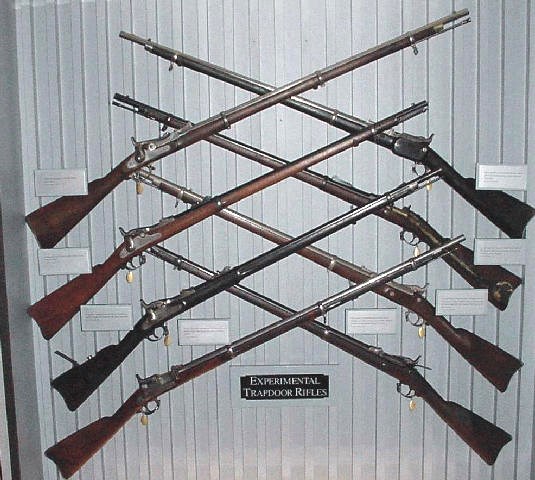
Springfield Armory NHS< US NPS Modifications Springfield Armory was an institution where creativity and experimentation were always welcome. New models of rifles and carbines were constantly being designed and developed by the Armory. Some of the weapons, such as the Trapdoors and 1903s, had long production lives, but the Armory never ceased trying to improve them. Modification, alteration, and adjustment to weapons and the machines to build them were keynotes of the Armory’s work. The collection of this museum reflects those qualities. There may be many dozens of examples of a specific model, but rarely are any twp pieces alike. The weapons displayed here are Trapdoor rifles and M1903 rifles; no two are precisely the same. The following rifles are mounted on the left from top to bottom: Allin test conversion of British Enfield SPAR1328 A triangular bayonet has been built into this Trapdoor rifle SPAR5790 The following rifles are mounted on the right from top to bottom: *****************
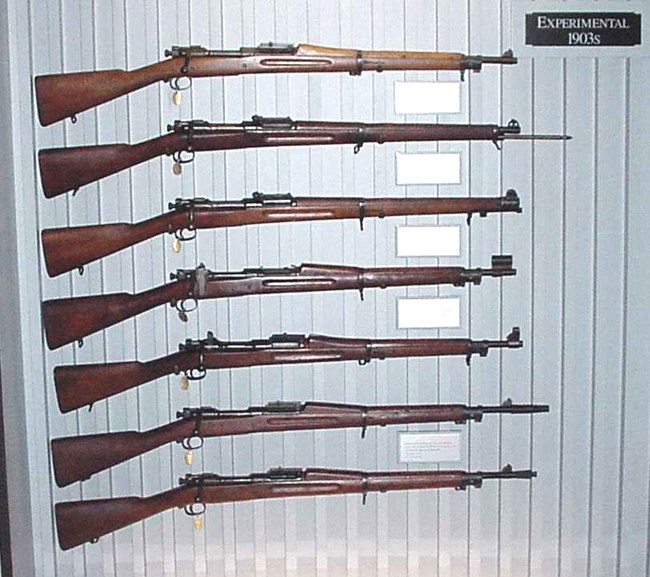
Springfield Armory NHS, US NPS Weapons displayed top to bottom: Constant experimentation on rifle sights led to many variations. These two M1903s exhibit differences in both front and rear sights. Some experimentation was done in attempting to reduce the recoil of the M1903. Two versions of a muzzle brake appear on these rifles. *******************
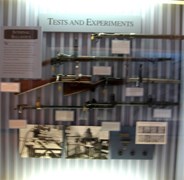
Springfiueld Armory NHS, US NPS Internal Ballistics While some tests studied the hitting power of the gun, powder, and bullet as a complete unit, others examined the interaction of individual components of the weapon, a science known as internal ballistics. Gun barrels had to be built to withstand the tremendous pressures created in them by the burning of the gun powder, especially the new, more powerful propellants. The pressure was measured by placing gauges over small holes drilled into the barrel. It was important often to know not only the pressure at the breech but also at points along the length of the barrel. Several gauges would be used in these cases. Mann Accuracy Barrel SPAR3728 This barrel is as close to being perfectly accurate as it was possible to achieve. It is used to test the performance of ammunition. Rounds are fired under conditions of controlled temperature, pressure, humidity, and wind. If the ammunition is consistent and the bullet perfect, each round would hit the same point on the target. The Mann barrel was used in testing the T65E5 cartridge, which became the standard NATO round. U.S. “Trapdoor” Rifle M1873 SPAR3757 An early example of an internal pressure testing device is this M1873 Trapdoor with a Rodman gauge. It is believed that this rifle and gauge were exhibited at the Centennial Exhibition in 1876. Pressure Test .30-06 Caliber Cartridge SPAR3747 The pressure created by firing a .30-06 cartridge was measured at two points in this test barrel. Pressure Test M1903 Action SPAR3734 The internal ballistics of the .224 cartridge were measured at two points in this test device. Pressure Test .22 Caliber Cartridge SPAR3738 Between World Wars I and II Springfield Armory helped finance itself by offering support services to civilian gun companies. One example of this aid was tests of .22 caliber ammunition using this test barrel. **************** 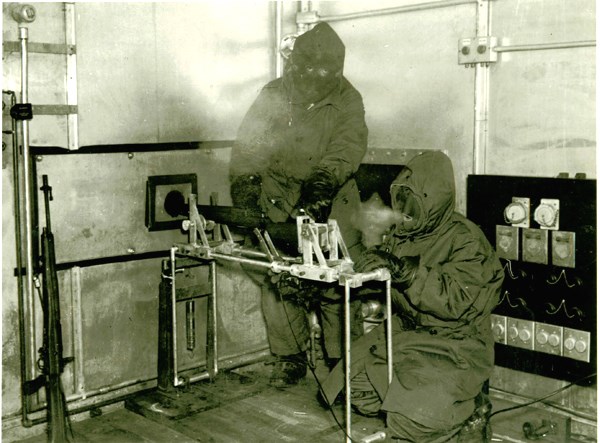
Springfield Armory NHS archives, US NPS 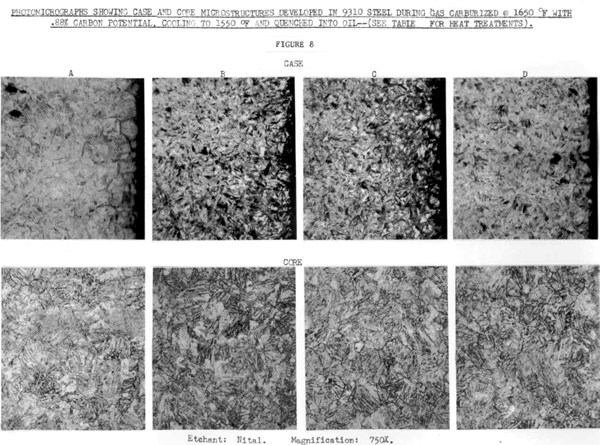
Springfield Armory NHS archives, US NPS 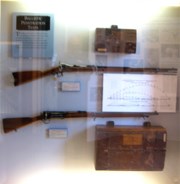
Springfield Armory NHS, US NPS Ballistics Penetration Tests The depth of penetration of a bullet fired from a weapon was an early method used by the Army to compare the relative power of weapons at a predetermined range. In the 18th and 19th centuries white pine was the material used in performing these tests, but the tests shown here were conducted using seasoned oak, a denser and much harder substance. U.S. “Trapdoor” Rifle M1873 SPAR758 .45-70 caliber; Distance: 25 feet; Penetration: 3.5 in. cross grain in seasoned oak; Velocity: 1315 feet per second U.S. Magazine Rifle “Krag-Jorgensen” M1898 SPAR766 .30-40 caliber; Distance: 25 feet; Penetration: 19.5 in. cross grain in seasoned oak; Velocity: 2470 feet per second ******************* 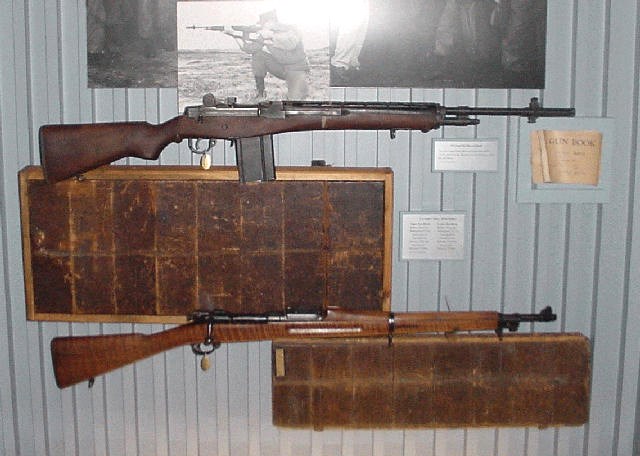
Springfield Armory NHS, US NPS M14 and Test Record Book SPAR3843 The M14 underwent extensive firing tests both in Alaska and Georgia. Results were recorded in a Test Record Book.
U.S. Rifle Caliber .30-06 M1903 SPAR765 Upper Test Block SPAR1079 Bullet: 220 grains; Penetration: 27.5 in. cross grain in seasoned oak; Velocity: 2300 feet per second; Distance: 25 feet Lower Test Block Bullet: 150 grains; Penetration: 27.5 in. cross grain in seasoned oak; Velocity: 2700 feet per second; Distance: 25 feet ****************** 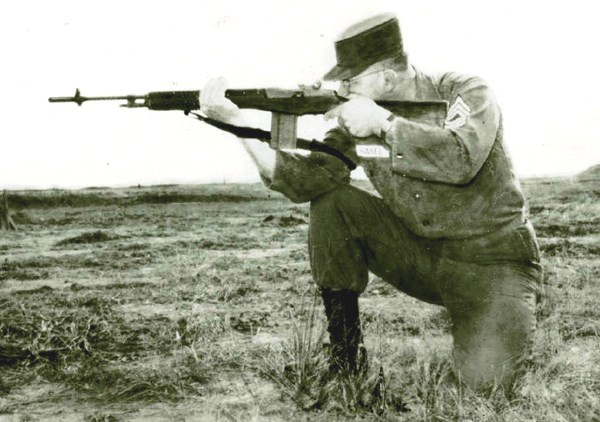
Springfield Armory NHS archives, US NPS 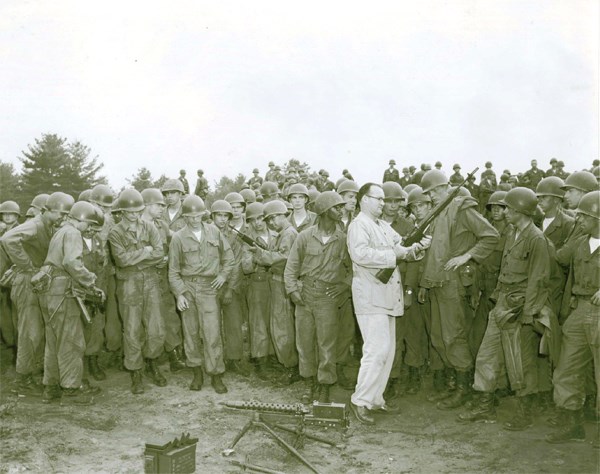
Springfield Armory NHS archives, US NPS |
Last updated: February 26, 2015
